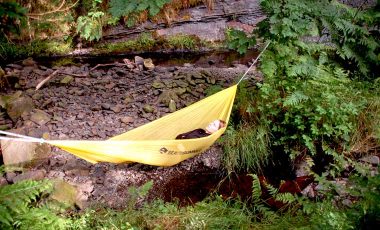Viewing a backpacking hammock with untrained eyes, we could be forgiven for thinking there’s not much to them…just a few bits of string with some cloth in the middle, right? Wrong! There are many surprising complex and numerous ins and outs of backpacking hammocks and so much more to them than you could ever imagine.
Below, we’re going to take you through what goes into the making of a good hammock so you know what to look for when choosing the best backpacking hammock for your camping adventures. You’ll also find a summary of each of the best backpacking hammocks out there.
- FAQs when choosing the best hammock for backpacking and camping
- The best lightweight backpacking hammocks in 2024
- What to look for when choosing a backpacking hammock
Summary of the best hammocks for backpacking
Disclaimer: We use affiliate links and may receive a small commission on purchases.
| Product | Weight | Features | Weight capacity | Cost |
|---|---|---|---|---|
| Yukon Outfitters SomniSmart Recycled Hammock | 567g / 1.25lb | Made from recycled plastic bottles | Not available | $$$ |
| Warbonnet Blackbird | 625g / 1.4lb | Roomy, Built-in bug net | 113kg / 250lb | $$$$$ |
| Ticket to the Moon Lightest Hammock | 228g / 0.5lb | Roomy and lightweight | 150kg / 330 lbs | $$ |
| Grand Trunk Ultralight Hammock | 350g / 0.7lb | Excellent value | 91kg / 200lb | $ |
| Hummingbird Ultralite Single Hammock | 147g / 0.3lb | Tiny when packed down | 136kg / 300lb | $$ |
| ENO Doublenest | 600g / 1.3lb | Fits two people | 181kg / 400lb | $$$ |
| DD XL Frontline Hammock | 1700g / 3.7lb | Roomy, built-in bug net with poles | 125kg / 276lb | $$$$ |
| Sea to Summit Ultralight Hammock | 155g / 0.3lb | Tiny when packed down | 136kg / 300lb | $$$ |
| Kammok Roo | 800g / 1.8lb | Fits two people, very strong | 227kg / 500lb | $$ |
| Hennessy Hammock Expedition Series | 1160g / 2.6lb | Includes tarp and bug net | 113kg / 250lb | $$$$$ |
| Grand Trunk Nano 7 | 200g / 0.6lb | Good value | 136kg / 300lb | $ |
| Serac Sequoia XL Double Hammock | 500g / 1.1lb | Fits two people, very strong | 227kg / 500lb | $$ |
FAQs when choosing the best hammock for backpacking camping
The Hummingbird Ultralite Single Hammock and the Sea to Summit Ultralight Hammock are two of the best hammocks for backpacking. They are both mega lightweight, highly portable and super easy to put up and take down.
If you need something that provides a little more comfort, space and protection, without sacrificing too much on weight and portability, the Warbonnet Blackbird is an excellent option that features a built-in bug net.
Yes! The benefits of hammock camping include:
- You can camp over water, swamps or rocky ground.
- Many people find hammock camping more comfortable than sleeping on the cold hard ground.
- Hammocks are quick and easy to set up and take down.
- Hammocks are usually lighter to carry than a regular tent.
- Sleeping in a hammock means you can enjoy the night sky.
- Ground critters and bugs can’t reach you when sleeping in a hammock.
- Hammocks are usually less expensive than lightweight tents.
For more information about the benefits of sleeping in a hammock read our guide to hammock camping.
The best hammock to sleep in is one that provides plenty of comfort and enough space for the type of hammock camping you wish to do. Bigger hammocks will provide more space to stretch out in and are often more comfortable as a result. If comfort is your main concern then take a look at the luxurious DD XL Frontline Hammock. This also features a built-in bug net which will add to your overall comfort levels if camping in damp or swampy areas.
If you want to share you hammock with another person you’ll want to consider the ENO Doublenest, Kammock Roo or the Serac Sequoia XL Double Hammock. These are also excellent options for single sleepers looking for extra sleeping space.
The best lightweight backpacking hammocks in 2024
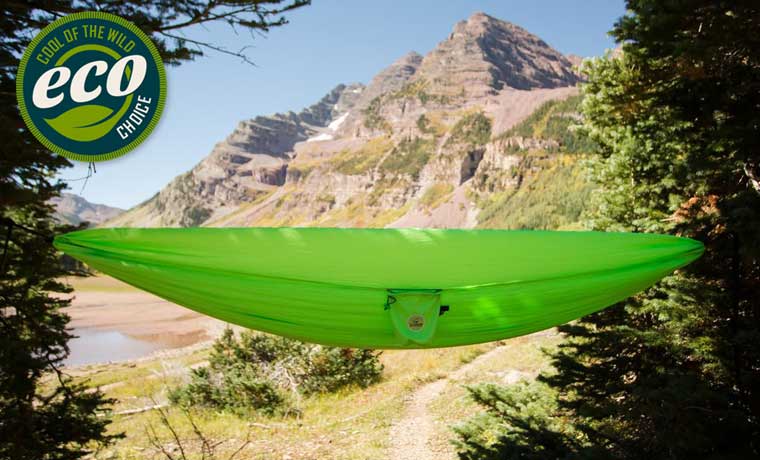
Yukon Outfitters SomniSmart Recycled Hammock
Approximately 9 recycled bottles are used to make one SomniSmart Recycled Hammock. The bottles are turned into eco-friendly and durable Repreve Fabric that is manufactured into a hammmock by Yukon Outfitters in the USA. This recreational hammock is moderately lightweight and packs down into a compact stuff sack, making it ideal for backpacking and lazy picnics alike. The SomniSmart is available in single or double version. The single is spacious and features a clever clinch-buckle suspension system which lets you hang and collapse the hammock in minutes. The clinch-buckle also allows for angle and tension adjustments without re-hanging the straps. It’s simple, easy to hang, lightweight AND eco-friendly!
Pros
- Made from durable and sustainable fabric
- Spacious size
- Easy and adjustable suspension system
- Available in single or double versions
Cons
- The fabric is prone to stains
- Limited colour options
Find the latest price at:
Yukon Outfitters

Warbonnet Blackbird
At only 624grams, measuring a generous 10ft x 5.25ft, and holding up to 250lbs, the Warbonnet Blackbird is a reasonably lightweight, spacious and sturdy hammock suitable for those measuring around six feet and under. Boasting a handy storage shelf, footbox, zippered bug net (hung from ridge-line), ribbon ties and a flat-lay feel, this is a solid, user-friendly, feature-rich workhorse and true contender for the most comfortable and easy-to-use backpacking hammock.
Pros
- Easy to set up and adjust
- Comes in larger and double-layered model
- Oh-so-comfortable
- Flat-lay feeling provided by spacious footbox
Cons
- Carabiners and tarp not included
- Pricey
If you are looking for something even more robust, and better suited to year round hammock camping, then take a look at the double layered Warbonnet Blackbird 1.7. A little heavier but able to deal with loads of up to 400lbs. The double layer also enables you to insert a sleeping pad for extra insulation.
For more information on the Warbonnet Blackbird 1.7 Hammock read our:
Full Review
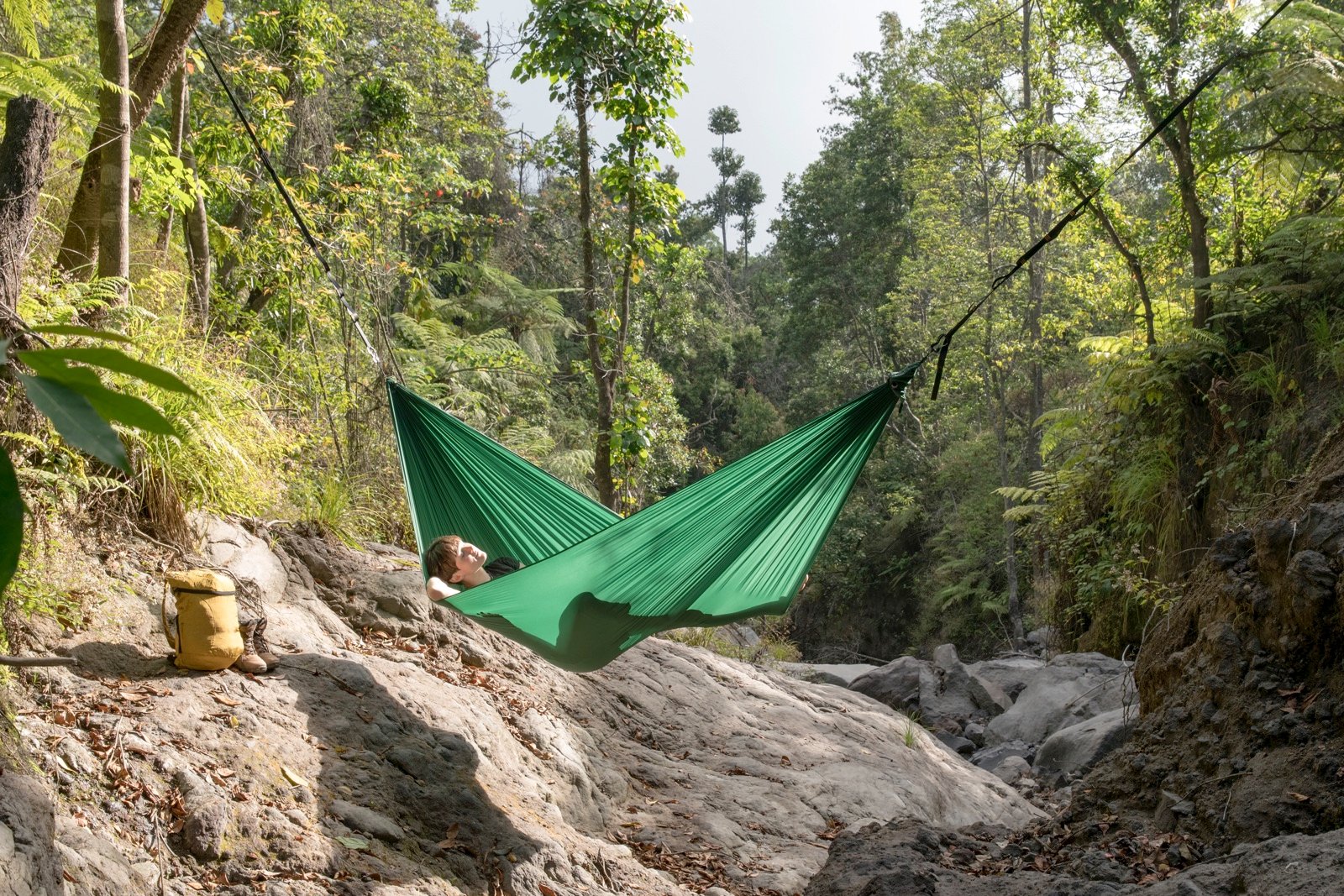
Ticket to the Moon Lightest Hammock
If you’re looking for a lightweight backpacking hammock but don’t want to sacrifice comfort and space to stretch out in, then the Ticket to the Moon Lightest Hammock is most certainly for you. Boasting 9.8 x 4.6 feet of space to wallow in, it competes fiercely with the heavier hammocks on our list. And yet, at only 228g / 0.5lbs, it’s one of the most lightweight hammocks, too.
It doesn’t pack down as small as the likes of the Sea to Summit Ultralight, but it comes with small carabiners to attach to the easy to set up Lightest Straps (90g / 3.4oz), which are sold separately. It’s a good value option for casual hammock campers, and the 10 year warranty is also highly appealing.
Ticket to the Moon takes its corporate social responsibility seriously, contributing a significant portion of its net earnings to the Ticket to the Moon Foundation.
Pros
- Lighteight
- Spacious
- Strong – can hold up to 330lbs
- Easy set up
Cons
- Straps not included
- Lack of features
Find the latest price at:
Ticket to the Moon
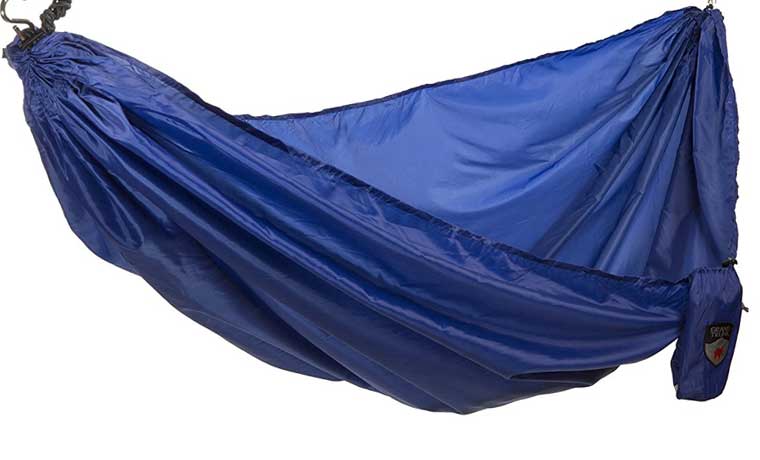
Grand Trunk Ultralight Hammock
At only 340g and measuring 9.5 x 4.5 feet, the Grand Trunk Ultralight is a single-person hammock low on features and frills but pleasingly inexpensive. Made of durable, mildew resistant and machine washable polyester taffeta, this is very much a middle-of-the-road, entry-level option best suited to smaller users (max. user weight is 200lbs). The Ultralight doesn’t quite keep up with its other single-person competitors such at the Hennessey Expedition or Warbonnet Blackbird, but it is an excellent option for those on a tight budget.
Pros
- The price – by far the cheapest hammock on review
- The weight (340g)
- Quick-drying polyester taffeta fabric
- Carabiners included
Cons
- No tarp or bug net
- Lack of features
- The weight – while light, 340g is much heavier than other ‘ultralight’ one-person models
Find the latest price on:
Amazon | Backcountry
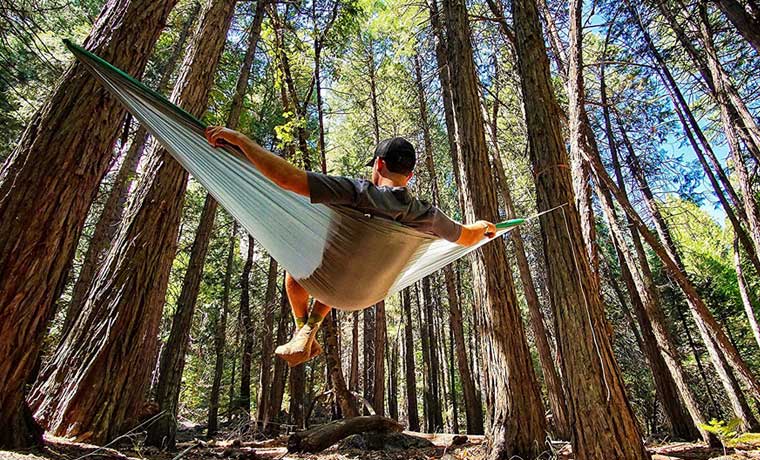
Hummingbird Ultralite Single Hammock
Weighing in at an incredibly feathery 147g and supporting up to 300lbs, the Hummingbird Ultralight Single might well be the best lightweight backpacking hammock on the market. Built to FAA parachute rigging standards and boasting rip-stop lock stitching, this hammock doesn’t scrimp on security and safety in favour of reduced weight. Not the roomiest or most comfortable hammock on the market, but ideal for those particularly keen to cut down on poundage and pack size. At a few grams lighter, an inch or so longer and a good few bucks cheaper, the Hummingbird Single just pips the Sea to Summit Ultralight to the post for the title of ‘Best Ultralight Hammock’!
Pros
- Ultra-ultralight – the lightest hammock in this review
- Packs down to tiny size
- Solid webbing and rigging
- Well-made
- Carabiners included
Cons
- A tad on the short and narrow side (8.6ft x 4ft)
- Not the most comfortable
- No tarp or tree straps
Find the latest price on:
Amazon
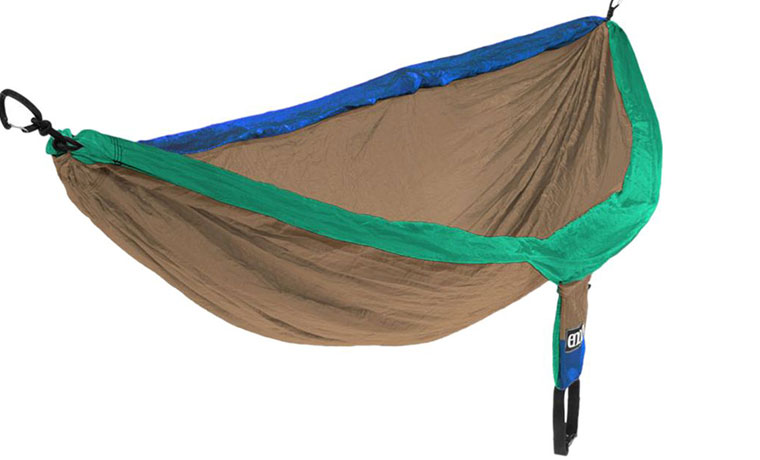
ENO Doublenest
Weighing in at a mere 600g, measuring 9ft x 6.2ft and supporting up to 400lbs, the ENO Doublenest could be classified as a very roomy one-person hammock or a suitable hammock for two relatively small people. Short on features but also low on weight, the Doublenest offers a decent lightweight alternative to the DD XL Frontline, Kammock Roo and Sequoia XL but ultimately falls short as a true two-person tent owing to its lack of length and low recommended user weight.
Pros
- Super-spacious for one person
- Easy to set up
- Carabiners included
- Breathable Nylon taffeta fabric
- Tiny pack size
Cons
- Suspension straps and tarp sold separately
- A tad cramped for two people
- No bug net
Find the latest price on:
Amazon | REI | Backcountry
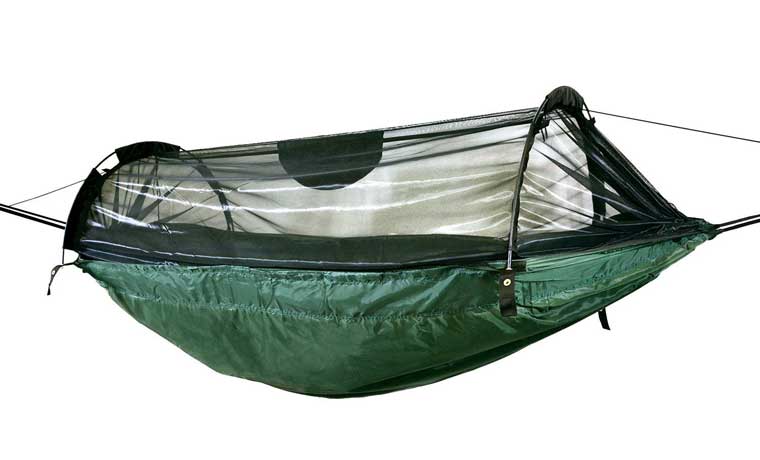
DD XL Frontline Hammock
While the DD XL Frontline is the heaviest and bulkiest of our items under review, it makes up for its pack size and 1250g weight (1700g with poles and webbing) with several desirable features and a general roominess that potential buyers may consider worth the hassle of carrying an extra few hundred grams. Boasting a zip either side of the mosquito net for easy access, a curved pole design to keep the net well away from the user, and a super-comfy, insulating double-layered bottom, this is very much the deluxe option for solo backpackers who place comfort above carry weight.
Pros
- Rugged
- Feature rich
- Very comfortable
- Double-layered bottom
- Double zip on bug mesh for easy entry
- Roomy
Cons
- A little on the heavy side
- No tarp
Find the latest price on:
Amazon
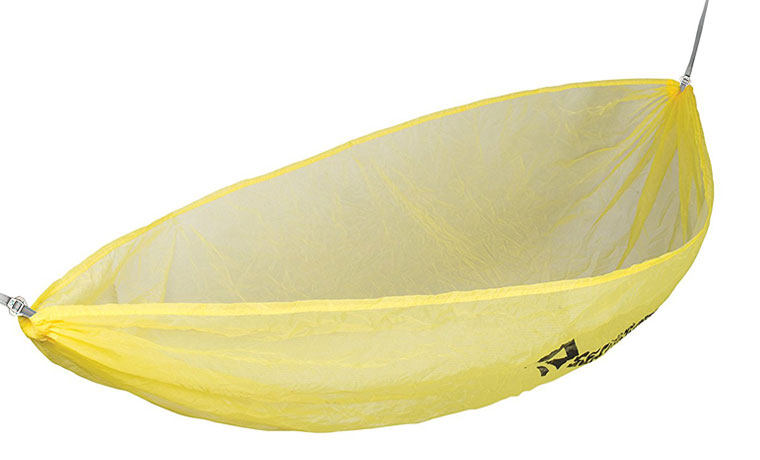
Sea to Summit Ultralight Hammock
At a mere 155g (5.4oz), the Sea to Summit Ultralight is the second lightest option in our review. Holding up to 300lbs and with similar dimensions (8.5ft x 4.5 ft), this highly minimalistic option is a fraction heavier than the Hummingbird, around half the weight of the Grand Trunk Ultralight and 45g lighter than the Nano 7. Along with the Hummingbird, and given its weight, strength and pack down size, this is a superb option for fast and light backpackers, or indeed for just throwing in your pack for a cheeky rest on a big day hike.
Pros
- Very light
- Strong – can hold up to 300lbs
- Breathable, rip-stop nylon
- Tiny pack size
- Easy to adjust
Cons
- Suspension straps and bug net not included
- Pricey
- A tad cramped for taller users – at 4.5ft wide and 8.5ft long, this is similar in dimensions to the Hummingbird and, as such, a little bit on the short and narrow side
For more information on the Sea to Summmit Ultralight Hammock read our full review.
Find the latest price on:
Sea to Summit | REI | Backcountry
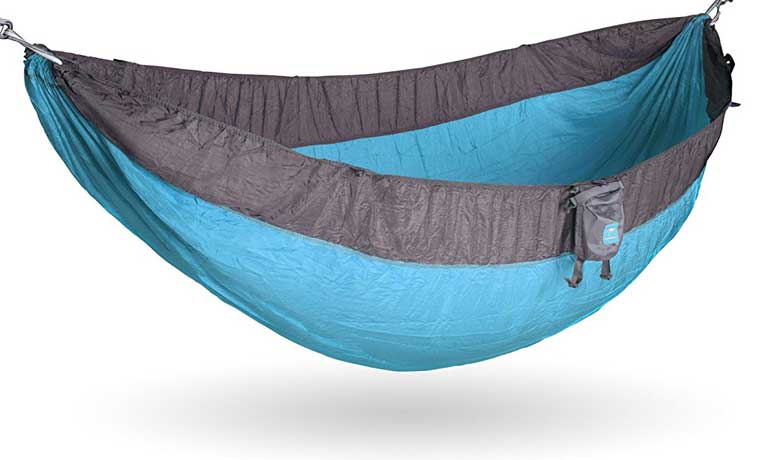
Kammok Roo
Holding up to a whopping 500lbs, measuring 10ft long by 5ft 7inches wide and weighing in at just 800g, the Kammok Roo is a spacious, tough, well-made product posing serious competition to the Serac Sequioa XL and DD XL Frontline for best two-person or ‘oversize’ backpacking hammock. Very high on comfort and second only to the ENO Doublenest (600g) in terms of weight for a two-person hammock, the Kammok Roo also bests the Sequoia and challenges the DD XL in terms of comfort, making it a great option for those looking to strike a balance between comfort and weight.
Pros
- Carabiners included
- Very comfortable
- Strong and durable
- Tear-resistant
Cons
- Insect net, straps and weather shelter/tarp sold separately
- Expensive with the additional outlay required for the above accessories
Find the latest price on:
Kammok | Amazon | REI | Backcountry

Hennessy Hammock Expedition Series
Boasting a generously-sized rainfly, an asymmetrical side zipper, inner mesh storage pocket and a roomy feel, the Hennessy Expedition is perhaps the most complete of all hammocks under review. Although weighing in at a fairly hefty 1160g, this weight includes (unlike other models on review) straps and rainfly/tarp. Designed, as the name suggests, for expedition use, this is the ideal hammock for anyone wishing to take things up a notch and spend a lot of time ‘hanging out’. As a potential tent-replacement hammock, the extra weight compared to other one-person models could actually turn out to be a saving if you opt to leave the tent at home. Ousts the Warbonnet Blackbird as competition for the best one-person expedition hammock on account of its lower price and weight (with separate tarp included) and overall functionality.
Pros
- Straps and tarp included
- Very robust, secure feel
- Could easily substitute a tent
- Very well-made
Cons
- Pricey
- Not as easy to set up as other models
Find the latest price on:
Amazon | REI
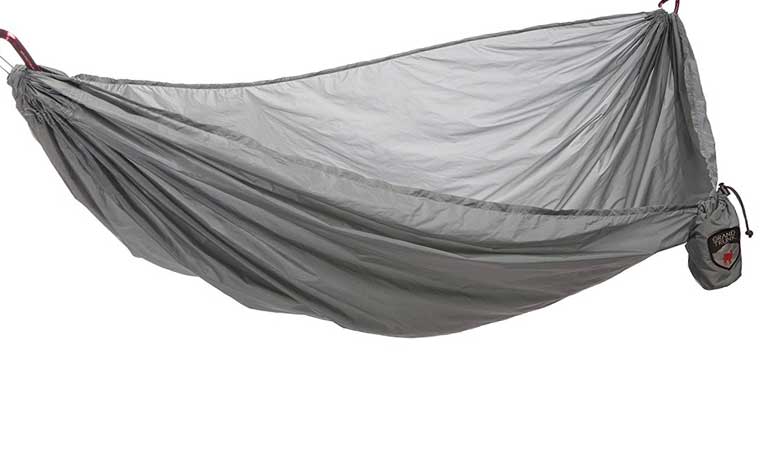
Grand Trunk Nano 7
The Nano 7 is an (absolutely) no frills, inexpensive, bare bones hammock that is as cheap as it is light. The world of backpacking hammocks, however, is no different from that of any other outdoor gear item and, as such, you get what you pay for. The Nano is a decent, throw-it-in-the-sack option for those unlikely to be spending too much time in their hammock but not comfortable enough for naps or sustained use. Compared to the Sea to Summit Ultralight Hammock and the Hummingbird (below), this hammock lacks in comfort, features and robustness while weighing around 50% more. A decent, compromise option for those on a serious budget or just wanting to give hammocking a try.
Pros
- Only 200g
- Cheap
- Carabiners included
Cons
- Tarp not included
- Less comfortable than other single-person and ultralight models
- Low weight rating
- No bug mesh
- Small (9ft x 4ft)
Find the latest price on:
Amazon | Backcountry
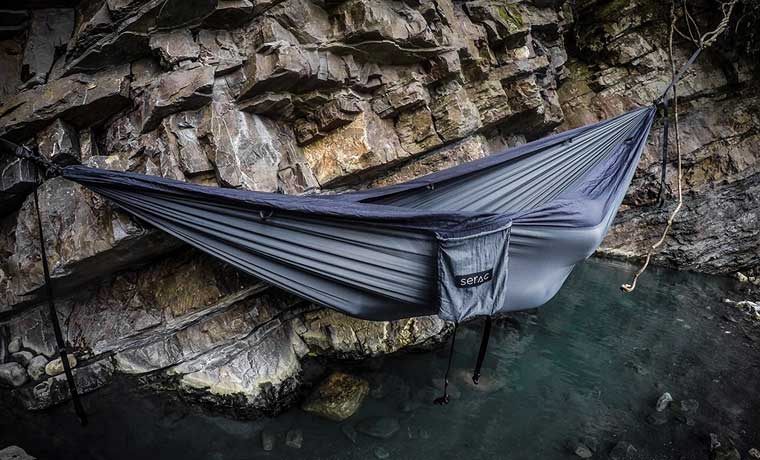
Serac Sequoia XL Double Hammock
Measuring 10ft x 5ft 7inches and weighing only 500g, the Serac Sequoia XL is lighter and roomier than most two-person hammocks currently on the market. While let down slightly by its unconvincing carabiners and lack of bug mesh, these failings are partially made up for by the 6 gear loops (that can double as anchor points for guylines or hanging accessories), its ease-of-use, and the whopping 10 anchor points which allow the user to adjust the height and slack to their own requirements. Despite the lack of bug mesh, the Sequioa is a competitor to the DD XL Frontline and Kammok Roo for best two-person hammock and is considerably lighter than both.
Pros
- Only 500g
- 5 year unlimited warranty
- Super spacious
- Easy to set up and adjust
- 10 anchor points
- Diamondweave ripstop nylon fabric
- Straps and carabiners included
Cons
- No tarp/rain fly or bug mesh
- Weak carabiners
Find the latest price on:
Amazon
What to look for when choosing a backpacking hammock
01Weight
When backpacking, weight is one of our foremost considerations. If you’re ditching your lightweight tent in favour of an even lighter, suspended setup then your pack needs to feel noticeably less heavy. Don’t forget that you’ll probably also need a tarp and/or a bug net, depending on where and when you are camping. And the combined weight of these shouldn’t end up being heavier than your tent.
Having said that, some backpacking hammocks, like the Sea to Summit Ultralight, are so inconceivably light that you can afford to stick one in your pack as well as your tent – the best of both worlds!
02Use
Certain hammocks excel in specific circumstances and environments. Some are workhorse, trail-ready, bug-proof, hovering homes – leave your tent behind and you’ll certainly not miss it. While others, bless them, are more suited to a day at the seaside, in the garden or very light, occasional use on the trail. What’s best for you will depend on where you’re headed and what you plan to use your hammock for.
03Standout Features
Many hammocks come with special add-ons, features or hammocking ‘bling’ that makes them stand out from the rest and may just sway your decision when buying. Among these features are rip-stop fabrics, superior maximum load, foot boxes, extra support or balancing lines, solid construction, insulation, double-zips on the bug mesh, storage pockets and extra length or width.
04Comfort
The raison d’etre for any hammock is the ability to increase the user’s comfort. Comfort-value is added or subtracted by a number of factors: fabric, length and width, breathability, layering, sleeping position (diagonal or straight, flat or raised-foot/curved) and the general feel of the hammock once you are in and airborne.
05Dimensions
Because you’d ideally like your feet to be in there too, the dimensions of your hammock are a key contributor to its overall comfort. For taller users, some models just don’t measure up and other products, particularly the ultralight variety, can skimp on width in order to minimise weight.
06Strength
While all hammocks come with a recommended user weight, it’s best to go for a material that you know to be durable, strong and able to withstand the elements, providing a few pounds of buffer for clothing or storage. While sleeping or lounging in a hammock is about as cool as you can get while out on the trail, all coolness would go out the window should your hammock decide to collapse while your trekking partners watch on.


